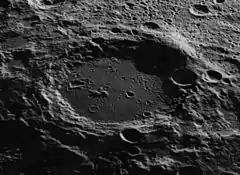Zeeman (crater)
Zeeman is a lunar impact crater located on the far side of the Moon near its south pole. It is not directly visible from the Earth. To the northwest of Zeeman lies the crater Numerov. Southeast of the rim is the crater Ashbrook.
 Clementine mosaic | |
| Coordinates | 75.2°S 134.8°W |
|---|---|
| Diameter | 184 km |
| Depth | Unknown |
| Colongitude | 135° at sunrise |
| Eponym | Pieter Zeeman |

The outer rim of Zeeman is eroded somewhat irregularly, with considerable variation in width of the inner slopes. The crater Zeeman Y lies across the northern wall, reaching almost to the relatively flat interior floor. In the western rim is a small crater that joins a gash that runs down to the floor. The surface of the interior is pock-marked by many tiny craterlets, and worn crater features. There is a low central rise, offset to the southeast of the interior midpoint.
An unusual, (officially) unnamed massif is present in the northwest section of the rim, which rises about 4.0 km above adjacent parts of the rim and about 7.57 km above the crater floor.[1] The formation of the massif does not appear to be explainable simply on the basis of the impact event that created the crater.[2]
Satellite craters
By convention these features are identified on lunar maps by placing the letter on the side of the crater midpoint that is closest to Zeeman.
| Zeeman | Latitude | Longitude | Diameter |
|---|---|---|---|
| E | 74.2° S | 123.9° W | 29 km |
| G | 74.3° S | 107.4° W | 45 km |
| U | 73.8° S | 148.2° W | 26 km |
| X | 71.5° S | 138.1° W | 26 km |
| Y | 72.8° S | 137.6° W | 33 km |
References
- Robinson, M. (20 November 2017). "Mountains of the Moon: Zeeman Mons". LROC.sese.asu. Arizona State University. Retrieved 5 September 2020.
- Ruefer, A.C.; James, P.B. (March 2020). "Zeeman Crater's Anomalous Massif" (PDF). 51st Lunar and Planetary Science Conference. p. 2673. Bibcode:2020LPI....51.2673R.
- Andersson, L. E.; Whitaker, E. A. (1982). NASA Catalogue of Lunar Nomenclature. NASA RP-1097.
- Blue, Jennifer (July 25, 2007). "Gazetteer of Planetary Nomenclature". USGS. Retrieved 2007-08-05.
- Bussey, B.; Spudis, P. (2004). The Clementine Atlas of the Moon. New York: Cambridge University Press. ISBN 978-0-521-81528-4.
- Cocks, Elijah E.; Cocks, Josiah C. (1995). Who's Who on the Moon: A Biographical Dictionary of Lunar Nomenclature. Tudor Publishers. ISBN 978-0-936389-27-1.
- McDowell, Jonathan (July 15, 2007). "Lunar Nomenclature". Jonathan's Space Report. Retrieved 2007-10-24.
- Menzel, D. H.; Minnaert, M.; Levin, B.; Dollfus, A.; Bell, B. (1971). "Report on Lunar Nomenclature by the Working Group of Commission 17 of the IAU". Space Science Reviews. 12 (2): 136–186. Bibcode:1971SSRv...12..136M. doi:10.1007/BF00171763.
- Moore, Patrick (2001). On the Moon. Sterling Publishing Co. ISBN 978-0-304-35469-6.
- Price, Fred W. (1988). The Moon Observer's Handbook. Cambridge University Press. ISBN 978-0-521-33500-3.
- Rükl, Antonín (1990). Atlas of the Moon. Kalmbach Books. ISBN 978-0-913135-17-4.
- Webb, Rev. T. W. (1962). Celestial Objects for Common Telescopes (6th revised ed.). Dover. ISBN 978-0-486-20917-3.
- Whitaker, Ewen A. (1999). Mapping and Naming the Moon. Cambridge University Press. ISBN 978-0-521-62248-6.
- Wlasuk, Peter T. (2000). Observing the Moon. Springer. ISBN 978-1-85233-193-1.